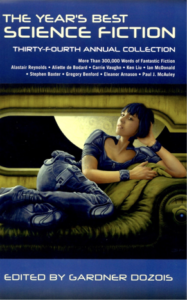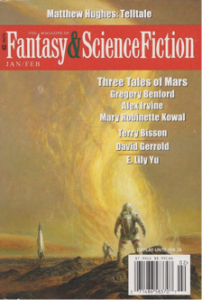 Since the first volume of The Year’s Best Science Fiction anthology in 1984, editor Gardner Dozois has been a staple to the science fiction genre with his collection of short stories and novellas from the prior year, as well as his lengthy reflections on the state of science fiction in print, as well as covering television and film — all of which constitutes most of each volume’s thorough introduction. There are several other high quality anthologies published yearly that frequently overlap in the works selected to be showcased. But Dozois should be given significant credit for championing short form science fiction for three and a half decades, even as the genre has evolved from mass market paperbacks and print magazines like Analog, Asimov and The Magazine of Fantasy & Science Fiction to e-books and online publications like Clarkesworld, Tor.com and Lightspeed.com. Reviews of some of our favorites from this year’s edition appear below.
Since the first volume of The Year’s Best Science Fiction anthology in 1984, editor Gardner Dozois has been a staple to the science fiction genre with his collection of short stories and novellas from the prior year, as well as his lengthy reflections on the state of science fiction in print, as well as covering television and film — all of which constitutes most of each volume’s thorough introduction. There are several other high quality anthologies published yearly that frequently overlap in the works selected to be showcased. But Dozois should be given significant credit for championing short form science fiction for three and a half decades, even as the genre has evolved from mass market paperbacks and print magazines like Analog, Asimov and The Magazine of Fantasy & Science Fiction to e-books and online publications like Clarkesworld, Tor.com and Lightspeed.com. Reviews of some of our favorites from this year’s edition appear below.
“Patience Lake” by Matthew Claxton
If Cormac McCarthy wrote a story about a militarized cyborg roaming Canadian farmland in search of repair (and please, Cormac, write that story!), it might look something like “Patience Lake.” Set in the near future, the story does a nice job of mixing genres — hard SF with a gritty modern cowboy drama. It follows Casey Kim, a veteran in constant need of repairing his many synthetic parts, as he is at first taken in by a small family operating a run-down farm, performing odd job repair work on their equipment in exchange for new parts for himself. But soon Casey finds himself in need of defending the family from a corrupt local law enforcer who is also in need of parts and money to maintain his far more advanced cybernetic components, which he procures by extorting and terrorizing the community. The story ends with Casey in nearly the same position as in the opening, which makes thematic sense, but we felt characters and setting were interesting enough to be expanded into a novella or novel.
“Vortex” by Gregory Benford
An entertaining story about two Australian scientists assisting Chinese explorers who have discovered an alien life form described as both plant and animal in a Martian cave. At times reminiscent of the cold war tension in Clarke’s 2010 (sequel to 2001), the political tensions back on Earth spill over into the action below and above Mars.
 “These Shadows Laugh” by Geoff Ryman
“These Shadows Laugh” by Geoff Ryman
A provocative story set in an alternative present in which an Amazonian-like race who resemble women (but are, in fact, neither women nor human) and procreate via parthenogenesis (development of an embryo from an unfertilized egg). It’s mostly described as a utopian society without ownership or marriage by the narrator, a woman from the Dominican Republic, which is an important reference to the place Columbus first made landfall.
“RedKing” by Craig DeLancey
A well executed, fast-paced cyberpunk short story in which nearly everyone has brain implants used for both work and pleasure. According the narrator, when hardware first moved “into the skull,” the goal was to wire directly into our occipital lobes for more immersive visual experiences. But in the world of “RedKing,” the wiring of the brain eventually spreads through our “neocortexes, like the roots of some cognitive weed. Autonomic functions came after, the wires reaching down into the subcortical regions of pleasure and pain, fear and joy. We gave up all secrets of our brains, sinking the wires ever deeper.” The narrator is a “code monkey” who helps the cops track down powerfully addictive programs and the coders responsible for creating and selling them. The program from which the story takes its name creates such a powerful hallucinatory effect on people, it can trick them into killing others. Worse, it can be spread like a virus. In a nice twist, the narrator has to infect himself with RedKing in order to figure out how it works and collect evidence against the hacker who wrote it.

“The Further Adventures of Mr. Costello” by David Gerrold
By the master of tribbles himself, David Gerrold delivers a novella length sequel to Theodore Sturgeon’s 1953 novelette, “Mr. Costello, Hero” — although it’s not necessary to read that story first. The tone of “Further Adventures” is very much in keeping with th high adventure, 50s style of SF. This highly readable and often entertaining yarn has Mr. Costello, as a futuristic PT Barnum, arriving on the rural planet Haven with a surefire scheme to corner the market on “horgs” — extremely dangerous predators which also happen to be an interstellar delicacy. The story is told from the perspective of the locals, highly cynical about Mr. Costello’s odds for success, to put it mildly. As you might imagine, things don’t go according to plan, although not in the way the reader might have expected.

Mika Model, Image credit Slate Magazine
“Mika Model” by Paolo Bacigalupi
This controversial story from one of the strongest writers in the genre was commissioned by Future Tense, a collaboration between Slate Magazine, New America and ASU. The story focuses on the issue of AI sentience and the question of corporate vs. personal responsibility in the case of a beautiful sexbot who freely admits to killing her owner. In the opening scene, a stunning Mika Model, a new highly intelligent and emotive robot, walks into a police station and requests a lawyer a moment before dropping a severed head on a detective’s desk. The story is told from the point of view of Detective Rivera, who is unequipped for the legal ramifications, asking himself, “Was it murder if a toaster burned down a house?” But he’s equally at a loss for the empathy he feels for the Mika Model, who apparently acted out of self-defense after her owner tortured her. Rivera appears confounded that Mika Models feel pain despite being purely software. In the end, it’s chocked up to a “user death,” with the Mika Models due to be upgraded to prevent further mishap, and Rivera is left questioning the authenticity of his own emotional response to an artificial being.
“Because Change Was The Ocean And We Lived By Her Mercy” by Charlie Jane Anders
Published initially in Jonathan Strahan’s Drowned Worlds anthology, this beautifully written story follows Pris and her life on the surface of a future San Francisco submerged under 25 feet of rising ocean. The story is less plot driven and more focused on drawing a compelling and troubled central character trying to survive in and repair the wreckage left by the twenty first century and form meaningful relationships with other characters. The setting is well drawn, especially in the lyrical descriptions of the ocean, the details of Pris’ life (making kelp and hemp clothing and diving for cultural artifacts in the city below) and the biotech filtration systems designed to both clean the contaminated ocean and provide food for the “Wrong Headed” community committed to repairing the environment. But the degree of ocean toxicity makes cleaning it a painfully slow process. Similarly, the level to which society has devolved causes Pris and other characters deep depression and, at times, near starvation. Much of North America seems to be a desert wasteland controlled by warlords. But the story ends on a somewhat positive note as Pris comes to terms with the fact that, like the ocean, society will heal itself slowly, in its own time.
Other stories which appear in this anthology were reviewed in the Recursor.TV post 2017 Shorts Worth Considering, featuring The Best Science Fiction of the Year Volume 2, published by Night Shade Book (April 4, 2107), ed. Neil Clarke — 27 short stories:
“Terminal” by Lavie Tidhar
“Things with Beard” by Sam J. Miller
“Touring with the Alien” by Carlyn Ives Gilman
“They Have All One Breath” by Karl Bunker
“The Iron Tactician” by Alastair Reynolds
For more, check out:
The Year’s Best Science Fiction, Thirty-Fourth Annual Collection
Edited by Gardner Dozois
Published July 11, 2017 by St. Martin’s Griffin
Includes 39 short stories and novellas